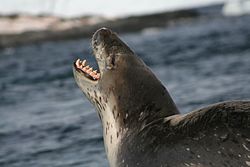Monachinae (original) (raw)
From Wikipedia, the free encyclopedia
Subfamily of carnivores
| Southern sealsTemporal range: Aquitanian–present PreꞒ Ꞓ O S D C P T J K Pg N Early Miocene – Holocene, possible late Oligocene record[1] | |
|---|---|
 |
|
| Leopard seal, Hydrurga leptonyx | |
| Scientific classification |
|
| Kingdom: | Animalia |
| Phylum: | Chordata |
| Class: | Mammalia |
| Order: | Carnivora |
| Suborder: | Caniformia |
| Parvorder: | Pinnipedia |
| Family: | Phocidae |
| Subfamily: | MonachinaeE. L. Trouessart, 1897 |
| Tribes | |
| Monachini E. L. Trouessart, 1897 Miroungini Muizon, 1981 Lobodontini J. E. Gray, 1869 |
Monachinae (known colloquially as "Southern seals") is a subfamily of Phocidae whose distribution is found in the tropical, temperate and polar regions of the Southern Hemisphere, though in the distant past fossil representatives have been found on both sides of the North Atlantic Ocean.[1][2] The difference between members of this group and members of Phocinae is in monachines the hindclaws are greatly reduced in size.[3] Furthermore, all species have 34 chromosomes.[3] There are three tribes recognized here: Monachini (monk seals), Miroungini (elephant seals), and Lobodontini (Antarctic seals and a handful of Afroamerican fossil genera).[4][5] While today represented by eight extant and one recently extinct species, Monachinae had an incredibly enriched fossil diversity that went into decline soon to be replaced by southern species of sea lions and fur seals.[6][5]
- ^ a b Leonard Dewaele; Olivier Lambert; Stephen Louwye (2018). "A critical revision of the fossil record, stratigraphy and diversity of the Neogene seal genus Monotherium (Carnivora, Phocidae)". Royal Society Open Science. 5 (5) 171669. Bibcode:2018RSOS....571669D. doi:10.1098/rsos.171669. PMC 5990722. PMID 29892365.
- ^ Stewart, Brent (2014). "Family Phocidae (Earless Seals)". In Wilson, D.E.; Mittermeier, R.A. (eds.). Handbook of the Mammals of the World – Volume 4. Barcelona: Lynx Ediciones. pp. 120–183. ISBN 978-84-96553-93-4.
- ^ a b Bonner, N. (1994). Seals and Sea Lions of the World. United Kingdom: Blandford. pp. 1–224. ISBN 978-0-8160-5717-7.
- ^ Berta, A.; Churchill, M. (2012). "Pinniped taxonomy: Review of currently recognized species and subspecies, and evidence used for their description". Mammal Review. 42 (3): 207–34. doi:10.1111/j.1365-2907.2011.00193.x.
- ^ a b Berta, A.; Churchill, M. & Boessenecker, R.W. (2018). "The Origin and Evolutionary Biology of Pinnipeds: Seals, Sea Lions, and Walruses". Annual Review of Earth and Planetary Sciences. 46: 203–228. Bibcode:2018AREPS..46..203B. doi:10.1146/annurev-earth-082517-010009. S2CID 135439365.
- ^ Yonezawa, T.; et al. (2009). "The monophyletic origin of sea lions and fur seals (Carnivora; Otariidae) in the Southern Hemisphere". Gene. 441 (1–2): 89–99. doi:10.1016/j.gene.2009.01.022. PMID 19254754.